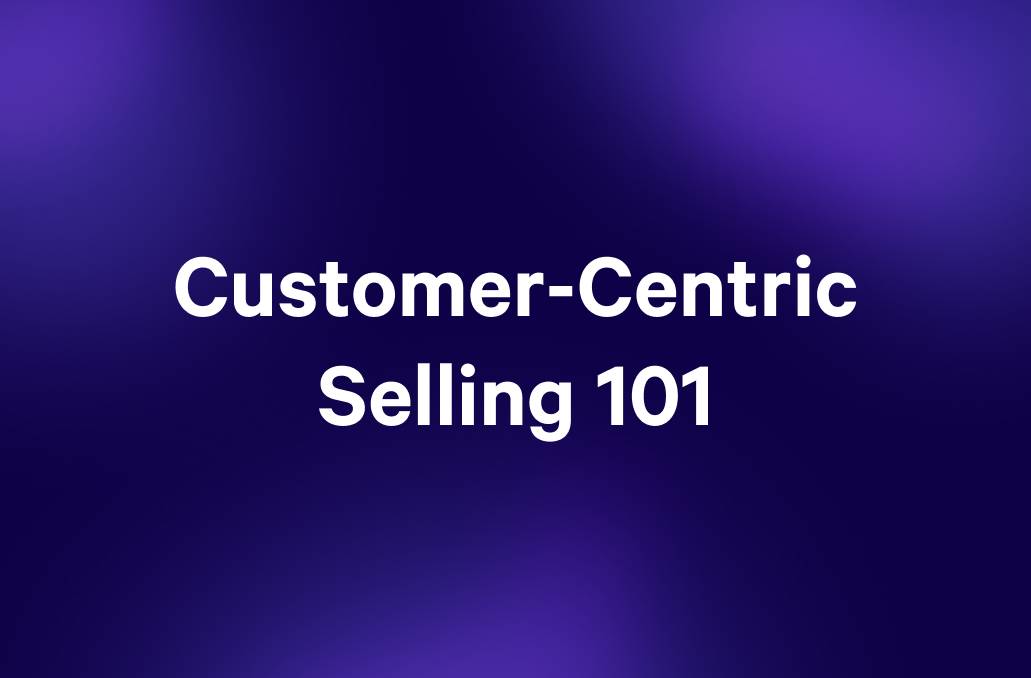Are you facing the challenge of ensuring your customer success team excels? You're not alone. Empowering your customer success team to support your customers is a critical function in many businesses that serve B2B customers. As we focus on both sales enablement and buyer enablement, the key lies in Customer Success Enablement, but getting there is no small feat.
Enablement managers and CS teams often grapple with inadequate tools and unclear processes, hindering performance and, with it, the customer experience. This is a miss because 88% of customers say customer support is now as important as the product or service itself.
Let’s look closer at what drives effective Customer Success Enablement and outline a strategy to arm your team with what they need to thrive.
What is customer success enablement?
If you work in sales or a sales-adjacent profession (like revenue operations), it’s very likely that you’ve heard of or participated in creating messaging for sales enablement. But, it’s also likely that the term customer success enablement is unfamiliar to you. This is because customer success enablement is a slightly newer kid on that block.
As the name implies, it provides customer success teams with the tools, training, and processes to support customers effectively. It's about creating a structure that supports your customers and those who serve them. Think of it as the stage crew of a theater — essential to the show, yet out of the spotlight.
This type of enablement, like sales or buyer enablement, involves a three-pronged approach:
1. Tools
For customer success enablement it’s imperative that you implement the best Customer Relationship Management (CRM) software, communication platforms, and data analysis tools that offer real-time insights into customer health. These tools streamline the process thereby allowing agents to deliver timely and personalized customer interactions and success plans. Another reason your enablement team should have these tools is that they can support the tracking of key performance indicators (kpis) to help services teams evaluate and improve the effectiveness of their programs.
2. Training
Developing a continuous learning environment through workshops, e-learning modules, playbooks, and peer-to-peer coaching can keep the team’s skills sharp and up-to-date with the latest product and service knowledge, as well as industry best practices.
While product training, especially around new releases is imperative for sales teams and service teams, when thinking about your customer enablement strategy it should be a pillar of the strategy to help enable your support team to provide the most relevant and up to date information to your customers.
3. Processes
Establishing clear and efficient workflows defining how to handle different customer scenarios ensures consistency and quality in every customer interaction. This quality can be measured using Net Promoter Scoring (NPS), follow up surveys and operational reviews.
Having clear processes may not be a client facing strategy, but it will shine through when customer interactions are consistent and efficient.
Customer Success Enablement isn't just about efficiency; it's about empowerment. When your team has the right mix of tools, knowledge, and processes, they can perform their roles confidently and effectively, leading to higher customer loyalty and satisfaction.
The importance of customer success enablement
Virtually all buyers now want to self-serve along their buyer journey, with 87% of business buyers now expecting the sales rep to act more as a trusted advisor. Customer success enablement helps businesses meet these evolving expectations.
When your customer success agents are well-equipped, they're not just solving problems—they're anticipating needs and advising customers and stakeholders. More sherpa than salespeople. Giving the customers exactly what they now want and need.
Here's why it's so crucial:
- Enhanced agent performance: Enablement gives agents access to the right information and tools at the right time, increasing their efficiency and effectiveness. This leads to faster resolutions, better customer interactions, and higher productivity.
- Consistent customer experience: With a strong enablement program, all agents follow the same high standards, ensuring every customer gets a uniform and high-quality experience, regardless of whom they interact with.
- Scalability: As your business grows, a solid customer success enablement framework can grow with it. Training can be standardized and scaled, processes can be automated, and tools can be leveraged to handle increased volume without sacrificing quality.
- Employee satisfaction and retention: Agents who feel supported are more engaged and have higher job satisfaction. This leads to lower turnover and creates a team of experienced and knowledgeable advocates for your customers.
- Data-driven insights: Enablement tools can capture and analyze data on customer interactions, providing valuable insights into customer behavior and trends. This can inform business decisions and help identify areas for improvement or refining product market fit.
- Customer retention and growth: Ultimately, well-supported agents lead to happier customers. Satisfied customers are more likely to stay with you - crucial for companies using a subscription-based model, such as Saas - and they're also more likely to expand their relationship through upsells and referrals.
By acknowledging the importance of customer success enablement, you're committing to a strategy that benefits everyone involved — from your agents and customers to your business's bottom line.
The elements of effective customer success enablement
Building an effective customer success enablement strategy involves more than just throwing a manual and some logins over the training room table; it requires a thoughtful and consistent training and support program. These are the elements that when combined, create a robust enablement framework:
1. Comprehensive onboarding
Onboarding programs should blend informational sessions about company policies and product details with interactive role-playing scenarios that simulate real customer interactions. New customer success managers (CSMs) might be paired with mentors for a period, allowing them to observe and learn the nuances of handling complex queries gracefully and efficiently.
2. Ongoing customer education and training
Structured, tiered training programs that evolve with the agent’s tenure ensure that learning is continuous and relevant. This includes deep dives into advanced product features, customer psychology, and soft skills that can turn a good customer experience into an exceptional one. Regular assessments and certifications can help keep track of each agent's progress and identify areas for further development.
3. Growing and maintaining an accessible knowledge base
Beyond a repository of FAQs, this dynamic database includes detailed case studies, resolution pathways, and real-time updates on known issues. Integration with the company’s CRM can enable agents to pull up historical data and solutions that have worked in the past, crafting informed strategies for current problems.
4. Clear processes and protocols
Clearly defined protocols for common and outlier customer scenarios help maintain consistency. These protocols should be mapped in detailed flowcharts, outlining customer pathways and the corresponding best practices for engagement, support, and resolution.
5. Empowering tools and technology
Select tools that integrate seamlessly with one another and provide actionable insights. For instance, a CRM that offers predictive analytics can alert agents to potential issues before they escalate. At the same time, communication tools with sentiment analysis can gauge customer mood and tailor interactions accordingly.
When choosing tools to add to your customer success enablement stack, remember to choose those that are easy to integrate into workflows and processes so that adoption of the tools remains high. Having the flashiest and most cutting-edge tools won’t help move the needle if your team can’t or doesn’t want to use them.
6. Feedback and improvement loop
A formalized process for capturing agent feedback on enablement tools and customer interactions can provide valuable insights for iterative improvement. Consider options such as digital feedback forms, regular debriefing sessions, and a system for tracking the implementation of suggestions.
Your customer success team members are the champions for your customers - giving them the opportunity to voice their needs and share feedback on needed improvements is a direct investment in your bottom line and should be considered part of your customer retention strategy.
7. Recognition and rewards systems
Having a system that not only recognizes and rewards top performers but also reinforces the behaviors you want to see and the skills you’re looking to develop on the team will help you get to where you want your team to be.
A well-structured rewards system might include performance and spot bonuses, non-monetary perks (like extra days off or a more desirable schedule), or recognition programs like 'Agent of the Month.' These systems should be tied to clear metrics reflecting customer satisfaction scores and successful enablement.
8. Supportive leadership
Leaders must be well-versed in the tools and processes their teams use. They should spend time on the front lines to understand agents' challenges and use this experience to advocate for resources that enhance enablement efforts.
By meticulously crafting each element of your customer success enablement strategy, you create an environment where agents are not merely informed but genuinely empowered (and motivated) to deliver peak performance consistently.
Metrics to measure customer success enablement
Understanding the impact of your customer success enablement efforts comes down to the metrics you track. These not only gauge current performance but also guide future strategies.
1. Agent performance metrics
Setting baseline and goal performance metrics for your customer success reps will help you determine how reps should be performing. If you’re new to setting these kinds of metrics, consider starting from industry best practices and seeing how your team compares. You can then set more realistic (but still aggressive) goals.
Average resolution time: Track how long it takes agents to resolve issues once they are identified. A reduction over time can indicate increased proficiency with tools and processes.
Customer Satisfaction Scores (CSAT): Measure the direct feedback from customers after interactions. High scores can reflect well-implemented enablement strategies.
First Contact Resolution (FCR): The percentage of issues resolved during the first interaction with a customer. An increase in FCR can suggest agents are well-prepared to handle various issues.
2. Training completion and proficiency levels
A robust training program is only as good as your team is leveraging it to build skills. Use these metrics to evaluate the effectiveness of your training and skill-building programs.
Module Completion Rates: Look at the percentage of agents completing required training within a set timeframe.
Assessment Scores: Evaluate the effectiveness of training by the scores on post-training assessments. Scores that trend upwards can show the training’s relevance and effectiveness.
3. Tool utilization and efficacy
Having state-of-the-art tools only drives change when they’re used correctly by the whole team. Having metrics to evaluate tool use and efficacy can help drive progress and allow you to reallocate the budget spent on underutilized and underperforming tools.
Adoption Rates: Analyze how many agents are actively using the tools provided.
Performance Impact: Assess the impact of tool usage on key performance indicators like resolution time and CSAT.
4. Process adherence rate
Having your team adhere to processes isn’t just about liking people to follow the rules. Its about establishing consistency to allow you to gather data on what is working and where processes fall short. Having a feedback loop (as previously discussed) will be what you can use to drive any needed change in your process.
Compliance Monitoring: Regularly audit interactions to ensure that agents follow the prescribed steps for customer engagement and issue resolution.
Deviation Analysis: When deviations occur, investigate whether they are due to individual error or if they suggest a need to update the processes to be more aligned with real-world scenarios.
5. Customer effort score (CES)
Evaluating your customer effort score regularly will allow you and your team to see how your CS offering is landing with customers. Lower scores suggest you should solicit more feedback to make needed improvements.
Transaction CES: Measure after specific interactions to assess how easy it was for customers to get their issues resolved.
Journey CES: Evaluate the ease of the customer journey as a whole, which can inform the effectiveness of your overall enablement approach.
6. Quality assurance scores
As with other metrics outlined assessing quality across the board and looking for trends will help ensure you build and maintain a best in class program.
Interaction Assessments: Have QA teams score a random set of interactions based on predefined criteria related to enablement, such as product knowledge and process adherence.
Trend Analysis: Look at QA scores over time to see if there is an improvement, indicating a successful enablement strategy.
By meticulously tracking these metrics, organizations can not only validate the effectiveness of their Customer Success Enablement efforts but can also pinpoint specific areas for optimization.
Challenges in Implementing Customer Success Enablement
Crafting an environment where customer success teams can flourish involves navigating challenges often as complex as the customers they serve. Here are some of the main challenges and some strategic approaches you can use to address them:
1. Comprehensive Agent Training
Keeping training materials up-to-date with product changes and market trends can be daunting.
- Implement a continuous improvement process for training content, leveraging feedback from agents and customers to keep materials relevant and effective.
2. Ensuring Consistent Use of Tools
Agents may resist adopting new tools due to familiarity with legacy systems or perceived complexity.
- Pair tool training with demonstrable benefits to their daily workflow and provide incentives for adoption. Use internal champions to encourage peer-to-peer learning.
3. Maintaining Quality at Scale
As your team grows, maintaining the quality of customer interactions can become more difficult.
- Standardize processes with detailed scripts and procedures and implement quality assurance checks to ensure consistency across the team.
4. Agent Autonomy vs. Process Adherence
Finding the balance between giving agents the freedom to personalize interactions and ensuring they follow best practices can sometimes be a tightrope act.
- Establish clear guidelines but allow for flexibility in customer interactions. Provide a framework within which agents can make decisions and be creative.
5. Agent Feedback Integration
We all know the importance of customer feedback, but the information you can get from your agents is often underutilized, leading to missed opportunities for improvement.
- Create structured channels for feedback, such as regular surveys or forums, and a clear process for evaluating and implementing this feedback.
6. Technological Adaptation and Integration
Integrating multiple tools into a cohesive system can be technically challenging and resource-intensive.
- Invest in integration platforms that can connect disparate systems and choose tools with open APIs and a proven track record of integration.
Preparation for these most common issues will flatten your learning curve, save you a hefty chunk of ‘trial and error’ time, and greatly accelerate the success of your customer enablement effort.
How Technology Drives Customer Success Enablement
There’s barely an aspect of modern life untouched by technology and I’m sure it won’t surprise you that it has a big part to play here, too, acting as both the foundation and the instrument for sophisticated customer engagement strategies.
Customer Relationship Management systems
Central to this is the implementation of a robust Customer Relationship Management (CRM) system that aggregates disparate customer data into a single, coherent resource. This enables customer success agents to deliver consistent, informed interactions by having comprehensive customer histories and preferences at their fingertips.
Analytics and reporting tools
Delving deeper, analytics and reporting tools emerge as indispensable allies. They dissect vast amounts of data to provide actionable insights into customer behavior and agent performance, shaping the future of training programs and procedural refinements. These tools also play a pivotal role in informing product development by highlighting usage patterns and customer feedback.
Automation
The efficiency of customer success operations receives a significant boost from workflow automation and task management tools (Qwilr’s easily customizable templates, for example, saving agents 75% of the time normally spent on sales collateral). By taking over repetitive tasks, these technologies allow agents to focus on cultivating high-value, personalized customer relationships. They also ensure that the operational backbone of customer success is both agile and resilient.
Self-serving options
Self-service technologies have seen a surge in importance, driven by customer preference for autonomy and efficiency. Knowledge bases, augmented by AI-driven chatbots, offer customers quick, self-guided resolutions to common problems. This not only improves the customer experience but also optimizes the allocation of agent time towards more complex, nuanced customer issues.
Omnichannel communications
Omnichannel communication platforms stand out for their ability to provide a seamless customer experience, whether the customer reaches out via email, chat, social media, or phone. The integration of these platforms ensures that the context of customer communications is preserved, enhancing both efficiency and customer satisfaction.
E-learning
The rise of remote work has cemented the status of e-learning and online training resources as cornerstones of agent development. These digital platforms ensure that no matter where agents are located, they have access to uniform, up-to-date training that keeps them at the forefront of customer success strategies.
Feedback systems
Feedback systems play a dual role; they are not only thermometers that measure customer and agent satisfaction but also compasses to guide the strategic direction of enablement tools. By systematically capturing and analyzing feedback, companies can iterate on their enablement strategies in real-time.
Artificial intelligence
Finally, the advent of AI and machine learning technologies marks a new chapter in customer success enablement. These technologies offer predictive insights into customer needs, enabling proactive service that can define the next era of customer success. The challenge lies in deploying these powerful tools in a way that remains transparent to the customer and faithful to the goal of enhancing their experience with your company.
Navigating the technological landscape is not just about adopting new tools; it's about weaving them into a comprehensive strategy that elevates every facet of customer success enablement, preparing teams to meet both today's needs and tomorrow's expectations.
The Future of Customer Success Enablement: Trends and Predictions
The horizon of Customer Success Enablement is dotted with emerging trends and technologies that promise to revolutionize the field further.
Predictive Analytics and AI are at the forefront of shaping the future of customer success. These technologies are becoming increasingly sophisticated, offering the ability to not just react to customer behaviors but to anticipate them. This foresight enables customer success teams to proactively address potential issues and seize opportunities to enhance the customer experience
Automation will continue to evolve, moving beyond routine tasks to more complex operations. As machine learning algorithms grow more advanced, we can expect them to take on a greater share of customer success functions, from segmenting customers to personalizing communication. Striking the right balance between automated efficiency and genuine human connection will remain a delicate endeavor.
Self-service technology will also become more prevalent as customers increasingly prefer to solve problems independently. Future self-service customer support platforms will likely incorporate more AI and natural language processing to provide more intuitive and effective support. Ensuring these tools are properly maintained and updated will be key to their success.
Remote work is another trend that's here to stay and is reshaping Customer Success Enablement. With remote and distributed teams becoming the norm, cloud-based enablement tools that support collaboration, communication, and education, regardless of location, will become increasingly important. For team members working from mobile devices or on public networks, it's wise to download iOS VPN solutions to ensure secure access to company systems.
This distributed model poses challenges in maintaining team cohesion and a unified company culture.
Data privacy and security considerations will become increasingly critical as customer success teams collect and utilize more personal data. Companies must navigate the complex landscape of data protection regulations while leveraging data to provide personalized customer experiences.
Professional development for customer success agents will also gain emphasis. As the role becomes more strategic, there will be a greater need for ongoing professional development opportunities that enable agents to build skills in areas like data analysis, strategic consulting, and customer psychology.
The future of Customer Success Enablement is one of both opportunity and challenge, requiring a strategic approach to leverage new technologies while maintaining the human touch at the heart of customer success.
FAQs
What does customer success enablement mean for the future of customer success roles?
Customer success enablement is set to broaden the scope of customer success roles, integrating deeper analytics, strategic account management, and proactive customer engagement. This evolution will require continuous learning and adaptation from customer success professionals.
How can technology be balanced with the human element in Customer Success Enablement?
Technology should be used to enhance, not replace, human interaction. Automation can handle routine tasks, while complex and sensitive issues should be navigated with a personal touch. Training and tools should focus on enhancing emotional intelligence and relationship-building skills.
What strategies can help ensure the successful implementation of customer success enablement?
Clear communication, comprehensive training, consistent feedback loops, leadership support, and a culture that values customer success are all critical for successful implementation.
Final Thoughts
It's clear now, more than ever, that the companies poised to lead invest deeply in empowering their customer success teams. The right mix of tech and touch, learning and leading, sets the stage for satisfied customers and passionate advocates. Ultimately, the true measure of our efforts is the success stories we help write for each customer every day.
Qwilr’s analytics give businesses valuable insight into their customer behavior, while our customizable proposal templates lead to a 75% reduction in time spent creating sales material. Time that can be re-directed where you need it most- driving revenue with that stellar customer experience. Vital tools for the modern seller. Try it for free today to see for yourself.
About the author

Marissa Taffer|Founder & President of M. Taffer Consulting
Marissa Taffer is the Founder & President of M. Taffer Consulting. She brings over 15 years of sales and marketing experience across various industries to a broad range of clients.



